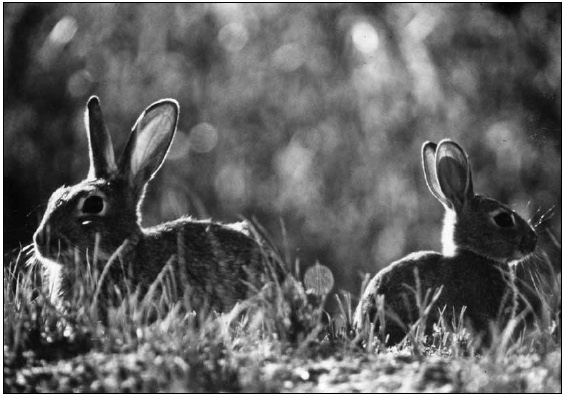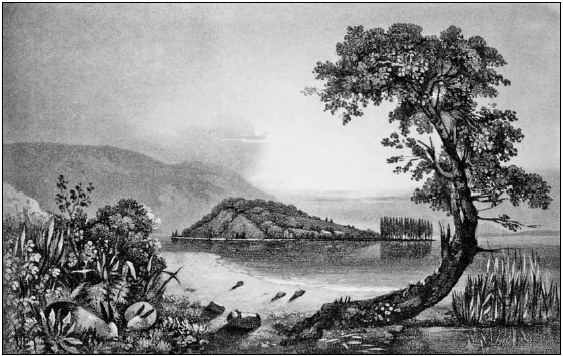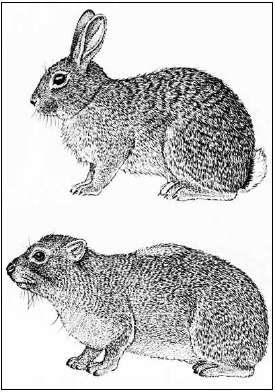The rabbits of St. Peter’s Island – an obituary
The rabbits of St. Peter’s Island – an obituary
Martin Luther was mistaken and Jean-Jacques Rousseau cheated
by Heini Hoffmann
There was a time when big wild rabbit colonies existed on St. Peter’s Island in Biel Lake, close to Geneva and Basle, in Ajoie, in Lower Valais and in the Magadino plain. Not anymore, as this wild species is nearly entirely extinct in Switzerland. As far as St. Peter’s Island is concerned, the wild rabbit story even has to be rewritten.

Originally, wild rabbits were spread out over large parts of Europe until a glacial period forced them towards Spain and North West Africa. Later, man helped them conquer the world by artificial propagation i.e. through releases into the wild. Roman warring armies, Portuguese seafarers, Norsemen and later colonisers gradually brought the little hobblers into the countries known to man at the time.
Often, it would be domesticated bunny rabbits that were released and that reverted back to being wild animals rather quickly – in fact, they did so quicker than any other domesticated animal would have been able to. Wildness always dominates the individual breed creations. But unrestricted procreation, e.g. on islands where no natural enemies are present, can lead to irreparable damage to the ecosystem. Australia serves as a prime example of this. Two dozen bunny rabbits that were brought over in 1859, developed into an uncontrollable plague of over 750 million at present.
This is where Luther was mistaken!
However, the rabbits didn’t just cause a stir because of their gigantic procreation, but they were also the cause of etymological confusion. When translating the bible from Hebrew to German, Martin Luther erronously fell victim to a zoological lapse. “Shãphãn” was translated to mean bunny rabbit. However, in Hebrew this term signifies “the one who hides” and is attributed to a dassy, a groundhoglike, rabbitcoloured rock dweller that is closely related to hoofed animals and elephants as well as manatees in particular.
1100 B.C., upon their arrival on the Iberian Peninsula, the Phoenicians had happened to discover animals, that when looked at from afar, reminded them of the dassies they knew from their home. That’s why they initially called the country “i-shãphãn-im” which later was latinized to “Hispaña”. Thus, “Spain” originally meant “land of dassies”. The highlight of this story is that even the Phoenicians got it wrong. The animals they wrongly thought to be dassies, were – unbeknownst to them – wild rabbits. So while Luther translated incorrectly, he termed them zoologically correctly.
There’s no “Habbit”!
Wild rabbits as well as hares are not classified as rodents inspite of their rodent teeth. And while a hybrid between a European hare and a snow hare in the overlapping areas is possible (bastards are infertile), it is impossible between hare and rabbit because the genetic differences are too significant. So there are neither “rares” nor “habbits”. The domestic rabbit species is only called that way because it was bred to have a very rabbit-like appearance.
And while the hare solitarily lives above ground and ducks – concealed by the colour of his fur – into his trough when sensing danger, wild rabbits live much more socially in colonies and inhabit self-dug caves. Their reputation of enormous fertility precedes them: Every year, the female rabbit gives birth to three or four litters with up to a dozen younglings in a subterranean birthing tube. Helpless nestlings, naked, blind, toothless and deaf. But they develop quickly.
What makes wild rabbits so likeable are – apart from the big dark eyes, the roundish head and the funny clattering – the ability to stand up and beg (when securing during feeding breaks), the long ears and the very special face. It is characterized by the split upper lip and the nasal blinking, a rhythmic retreat of the fur fold covering the nostrils. Or the jolly, hasty chewing movements during the crushing of food, called “nibbling” (“mümmeln”). Evidently, Jean-Jacques Rousseau succumbed to all of these charm factors as well.
The Rousseau legend
Born in Geneva in 1712, the philosopher Rousseau ruffled quite a few feathers in politics as well as in church with his new ideas and thinking. After his escape from France in 1762, he found refuge in Môtiers in the Val-de-Travers, formerly the Prussian Principality of Neuchâtel, because he was no longer welcome in his place of birth. However, in 1765 he was forced to flee from there again.
His next, short stop was (from 12 September to 24 October 1765) St. Peter’s Island in Lake Biel, from where he was expelled again by the Bernese Senate, only to return to France via England, where eventually, he died in 1778. The story of him allegedly releasing wild rabbits on his beloved St. Peter’s Island has been frequently circulated. However, that is inaccurate. He released domestic rabbits than subsequently then turned feral.
In his time, long before the Jura waters formed a peninsula from St. Peter’s Island, it consisted of two islands, the larger (today’s) one where he lived, and a smaller one in the area of today’s Heidenweg, to which he withdrew frequently. It was on this site that the animals were abandoned, which is why the name Chüngeli Island (Rabbit Island) remained long after the colony had ceased to exist. It was not until the 1980s that Biel hunters on the present peninsula released real rabbits. But one thing after another!

Return to nature trick
On St. Peter’s Island, Jean-Jacques Rousseau – disillusioned by constant persecution – found his inner peace and decided to follow only nature, emotion and the immediate perception of the senses. In his last work “Rêveries du promeneur solitaire”, the 64 year old described his happiness and regained peace of mind. This love for the dreamy island gave rise to the desire to enliven this microparadise with likeable hoppers.
With the help of the large island’s proprietor (who, as owners of poultry and pigeons, were versed in raising small animals), rabbits were brought in from Neuchâtel and released with a proper ceremony. Of course, within a few generations, Rousseau’s spotted domestic rabbit colony turned feral again because in freedom, wild animals dominate tame ones, and thus returned to their brown wild colouring. Having mutated into pseudo-rabbits like that, the pet rabbits (“Hus-Chüngeli”) later were offered at the Berne “Burgerspital” (retirement home for the Citizen’s Community of Berne) banquet as genuine venison…
With his experiment, Rousseau performed an unintended trick in the spirit of “return to nature”. What he did with great joy is no longer be compatible with environmental standards concerning nature conservation today. But we don’t want to join the chorus of those placing blame retrospectively. In addition, he was not the only one to release animals. It is assumed that quite a few of the current Central European wild rabbit population descended from escaped or abandoned domestic rabbits.
They were house rabbits!
Rousseau himself never spoke of wild rabbits, they did not exist in Switzerland at the time. The animals from Neuchâtel could be transported in an open basket while on the ship. Rabbits, however, are skittish escape animals and can only be transported in cages. Rousseau also writes that among the Neuchâtel rabbits, there were “male and female ones”. Since wild rabbits do not show any pronounced sex dimorphism, i.e. the female and the male rabbit hardly differ from each other externally, the outer sex organs should have been examined for the determination. They are situated in front of the anus (“Weidloch”) and only become visible after a slight pull on the covering skin area, which would have led to a small rodeo trying to pin the wild animals down – and that doesn’t fit in with Rousseau.
Pictures from that time also confirm the rabbit theory: As depicted by “L’ Embarquement” by Daniel Lafond, Rousseau seizes a white (!) rabbit (not entirely correctly) by the collar, which in turn behaves rather docile. The two rabbits in the front left-hand corner of Sigismond Himely’s acquatint are a very old domestic rabbit breed with plate spotting, the Brabant rabbits which were depicted in pictures as early as in the 16th century and from which today’s rabbit breed called the Dutch descended.
Also, Gabriel Ludwig Lory’s painting shows that the rabbits in the right corner of the scene are not-so-shy “Hus-Chüngeli” (pet rabbits) in broad daylight. The same goes for another painting by Daniel Lafond; here you can see (also at the embarquement on Chüngeli Island) a little boy running towards a white rabbit with black ears with his arms outstretched in order to embrace it. The little animal, at barely a metre’s distance and facing him, calmly stays in its place and does not flee in a panic. Ergo: Clearly a tame domestic rabbit! The evidence is overwhelming, although due to artistic freedom, caution is advised when it comes to old paintings and the colour of the animal breeds depicted in them.

No wild rabbits until later
Time leap: In the middle of the 19th century, specialist literature did not know of wild rabbits on Swiss soil. So evidently, Rousseau’s rabbit colony didn’t survive very long. Unfortunately, no documents have been found about that or the release of actual hares on St. Peter’s Island by “open-minded Biel hunters” in the 1880s so far. It goes without saying that these green skirts released authentic wild rabbits and not domestic ones. Their descendants were scientifically examined in the 1970s and 1980s by wildlife biologist Charles Huber of Berne Natural History Museum (cf. infobox).
In the 1980s, the St. Peter’s Island colony started to decline and in the 1990s it took a turn for the worse. No one, neither the researcher who then turned to other subjects, nor the former gamekeeper Fritz Maurer from Müntschemier nor the historian and St. Peter’s Island expert Andres Moser from Erlach know any details about what happened. As so often in nature, it was probably a multifactorial event that manifested itself almost simultaneously in the other colonies in Switzerland and neighbouring countries. At that time, Germany suffered dramatic losses in its wild rabbit population, to the point as having to declare the species as close to extinction.
After having survived for over a hundred years, the rabbit population on St. Peter’s Island had definitely died out by the early 1990s, although tourist information boards on the still dreamy peninsula would still advertise the alleged presence of the small pawing diggers years later…

Sad end without mourning
Today, wild rabbits have become extinct not only on St. Peter’s Island in Lake Biel, but also in the Lower Valais (where they mixed with domestic rabbits), in the Ajoie, in the Magadino plains and near Geneva and Basle, where they used to spread as far as the suburban gardens. Only close to Geneva, near Bardonnex on the border, there is a shrinking colony, as well as in the central Valais (Sion) that serves as the food source for the eagle owl living there.
The pressure of civilisation, agriculture and people’s leisure activities on wild rabbit colonies was increasing. Especially parasites, RHD and myxomatosis viruses and other diseases, inbreeding due to isolation of individual populations, increased fox and bird of prey density as well as stray cats and unattended dogs were the main hazards of the hopplers.
Perhaps the most surprising thing about this exodus story was the fact that while the extinction of other species leads to big headlines, political advances and last desperate research projects, the wild hobblers quietly bid their farewell without anyone noticing. Does anyone take pity on these animals now? The wild rabbits – and this applies to all former Swiss colonies – were originally released, i.e. they are a “falsification of fauna”. Their disappearance, unlike a known and popular or interesting hunting species, did not seem to cause for great mourning. In short: A wild animal species, which was the direct predecessor of one of our farm animal species, silently and quietly says goodbye. •
(Translation Current Concerns)
A Rousseau-rabbit replica
hh. Charles Huber’s wild rabbit research results in the rear-view mirror: The best of this species’ era (under preservation since 1972) summarised at the end of the 1970’s and found on the St. Peter’s Island with approximately 600 dens and more than 1,200 animals. It leaves behind passages and tubes, but also gnawing marks on bushes and trees as well as damage from gnawing on cultivated farm plants. Thanks to the reduction-shooting (200 animals) and the introduction of 14 martens a tolerable balance could be established.
One also learned to minimize the damage through gnawing by protecting grapevines and tree trunks with chicken wire or by leaving the branches of fruit trees, pruned in winter, on the ground. This change was also good for the rabbit since it is more strenuous to chew the bark of living trees up to a height of 30 centimetres. So easy! The killed animals were used by researchers to obtain useful data about the reproduction rates and the age structures. It was once shown how hard nature can be: almost 70 per cent of the young animals did not survive beyond the age of one year. Because of that, reproduction was large-scale.
An interesting detail: in addition to the characteristic colony on the (formerly large) island, there are a couple of less-often frequented dens along the Heidenweg (in the area of the formerly small island), amidst several vacation houses. It is also possible that a pair of pet rabbits have escaped since Charles Huber suddenly discovered tabby animals which after a few generations (the body-colour is dominant!) disappeared again. A Rousseau-replica!